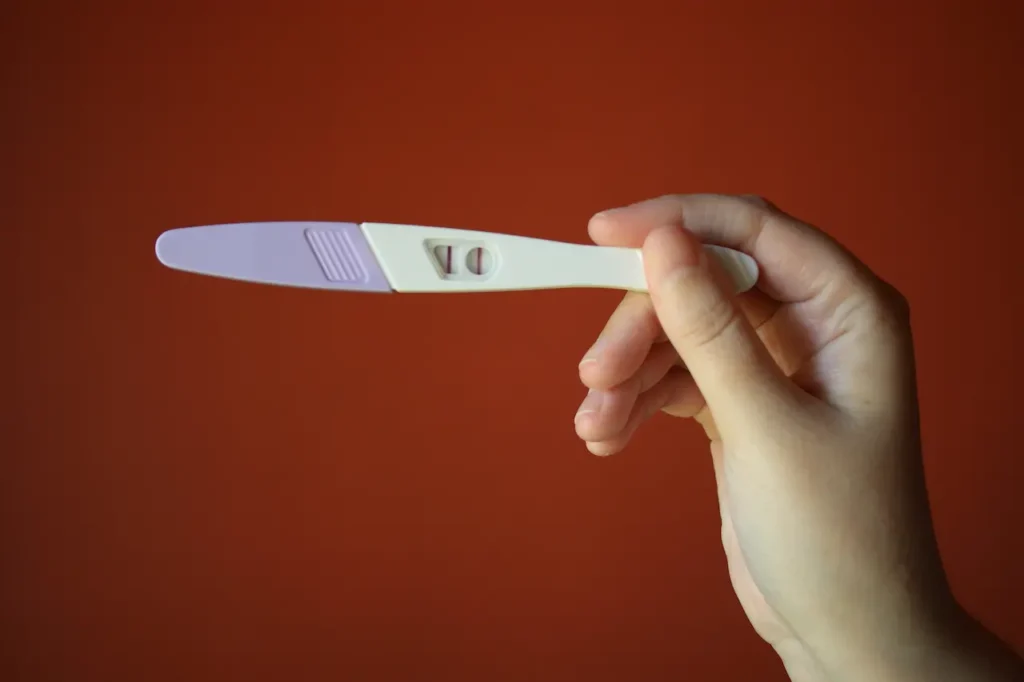
How Do Home Pregnancy Tests Work?
Typically, an OTC pregnancy test checks your urine for the presence of HCG. There are a few ways to collect your urine for the test:
-
Dip Method: Collect urine in a clean cup and dip the test stick into the urine.
-
Dropper Method: Use an eyedropper to transfer a small amount of urine into the provided container, then apply it to the test stick.
-
Midstream Method: Simply hold the test stick under the urine stream.
Once you’ve collected the urine, follow the test’s instructions carefully to get accurate results.
When Should You Take a Pregnancy Test?
The best time to take a pregnancy test is after you’ve missed your period. Most home pregnancy tests are about 99% accurate when used correctly after a missed period, according to the Cleveland Clinic. If you want to test earlier, you can wait about one to two weeks after sex if you’re anxious to find out but haven’t yet missed a period. It typically takes 7 to 12 days after fertilization for your body to start producing detectable levels of HCG.
Taking the test too early can give inaccurate results, so if you test too soon, be sure to try again a few days later if you still don’t get your period.
How Accurate Are Home Pregnancy Tests?
Home pregnancy tests are highly accurate, but they’re not foolproof. They detect HCG in your urine, but different brands can detect different levels of HCG, so the accuracy can vary. Early in pregnancy, HCG levels may be too low for some tests to pick up, leading to false-negative results. If you get a negative result but don’t get your period in a few days, it’s a good idea to retest.
How Will You Know if You’re Pregnant? Understanding the Results
After the test has been processed, the results will typically show up in one of three ways:
- A color change: A color shift indicates pregnancy.
- A line: The test might display a line (or lines) where indicated.
- A symbol: Some tests use symbols, like a plus (+) or minus (–) sign.
- Words: Some tests display clear messages like “Pregnant” or “Not Pregnant”.
If you see any of these indicators, make sure to follow the test instructions carefully to understand the results fully.
Signs That You Might Be Pregnant
If you’re not sure whether to take a test, several signs might prompt you to pick one up. These include:
1. You’ve Missed Your Period
A missed period is often the first sign of pregnancy. If your menstrual cycle is usually regular and you’ve missed your period, it’s time to take a test. However, keep in mind that stress, diet changes, intense physical activity, or certain medical conditions can also delay or stop your period. Keep track of any changes in your cycle, and remember that spotting or light bleeding can also occur in early pregnancy as the fertilized egg implants in your uterus.
You might also like: How to Deal with Pregnancy Heartburn
2. You’re Experiencing Cramps
Cramps in early pregnancy can feel similar to menstrual cramps, but they don’t signal the arrival of your period. Some women experience cramping as the fertilized egg implants itself into the uterine wall. If you have cramps but no period, a pregnancy test may help clarify whether you’re pregnant.
3. Your Breasts Are Sore
During early pregnancy, your body starts producing more progesterone, which can cause your breasts to feel tender, swollen, or more sensitive than usual. You might also notice darker veins beneath your skin. However, breast discomfort is not always a sign of pregnancy, as many women experience breast tenderness before their period.
4. You’re Feeling Different
Pregnancy symptoms can vary, but common signs include:
- Nausea or vomiting
- Food aversions or cravings
- Increased fatigue
- Frequent urination
Even before your HCG levels peak in the first trimester, some of these symptoms may appear and get worse over time. If any of these seem familiar, consider taking a test.
5. Your Birth Control Failed
While birth control is highly effective, no contraceptive method is 100% foolproof. Human error, like forgetting to take a pill or using condoms improperly, can lead to pregnancy. Even perfect use doesn’t guarantee prevention. According to Planned Parenthood, 9 out of every 100 women using birth control pills as directed will become pregnant each year. Additionally, about 18 out of 100 women who use condoms may get pregnant annually.
If you’ve used contraception and still experience pregnancy symptoms, it’s worth taking a test to be sure.

What Should You Do Next?
If you take a home pregnancy test and the result is positive, congratulations! The next step is to schedule a visit with your doctor or an OB-GYN to confirm the pregnancy and start prenatal care. If the test is negative and you don’t get your period after a few days, retake the test or talk to your healthcare provider for further guidance.
If your test is negative but you still suspect you might be pregnant, especially if you’re experiencing symptoms, don’t hesitate to seek medical advice. A doctor can help you interpret results and discuss the next steps.
There Are Many Different Types of Pregnancy Tests
There are many different types of pregnancy tests available. Each has its accuracy and method. Understanding the options available can help you decide which test is best for you, whether you are considering a home pregnancy test or a blood test at your doctor’s. Take a look at how the different types of pregnancy tests work.
Urine Tests
Urine Tests are performed in two ways: either at home or in the clinic. The first method involves collecting urine in a container and then dipping a stick or an eyedropper into it. One way is to place a stick in your urine stream and catch your urine midstream.
The time it takes to receive a test result varies. Look for a change of color, a line, or a symbol, such as a plus or negative. Clearblue Easy’s new digital pregnancy test makes it easy to read your results: The window will display the words “not pregnant” or “pregnant”.
To get an accurate reading, it’s important to carefully follow the instructions that come with each test.
How Soon Can I Take a Urine Sample?
The majority of doctors will recommend waiting until the first day after your missed period to take a urine test. This usually happens about 2 weeks after conception. Some tests are more sensitive and can be done earlier.
How Accurate are Urine Test Results?
When done correctly, urine tests or home pregnancy tests are 97% accurate. Home pregnancy tests can be used because they are convenient, low-cost (ranging from $7.99 up to $19.99), fast, easy, and private.
If you get a negative result and still have symptoms of pregnancy (missed period, nausea during pregnancy, breast tenderness, etc.) wait a week before taking another test or contact your doctor to arrange a blood test. If you receive a negative test result but still experience symptoms (missed period, nausea, and breast tenderness), you should wait one week before taking another test. You can also contact your doctor to have a blood test done.
Blood Tests
There are two kinds of tests. A qualitative hCG test provides a simple yes/no answer as to whether or not you are pregnant.
Benefits of a Blood Test:
- It can detect pregnancy up to 7-12 days before conception. (If a negative test result is obtained, the test should be repeated.
- You can measure the hCG concentration in your blood. This information is helpful to your doctor in tracking certain pregnancy problems.
The Disadvantages of a Blood Test:
- The price is higher than that of a urine test. (Price is determined by the doctor’s fee and lab fees.)
- It takes longer to get the results
- It must be done at a doctor’s office
Facts About Pregnancy Tests
Understanding the timing, accuracy, and workings of pregnancy tests can help you to make an informed decision during this crucial time.
Does a Positive Pregnancy Test at Home Mean That I am Pregnant?
Positive results from a home pregnancy test indicate the presence of hCG hormone in your body. When an egg implants in the uterine lining of a woman, hCG begins to multiply and develop. This is an indication that you are pregnant.
You might also like: Pregnancy Struggles.
Does a Negative Pregnancy Test Result Mean That I’m Not Pregnant?
Negative results can indicate that you’re not pregnant, that you tested too early, or that you did the test incorrectly. The sensitivity of pregnancy tests (how quickly they detect the hormone hCG) varies. You may not have allowed your body to produce enough hCG hormones that will show on the test.
If you leave a test sitting for too long, the test will be invalid. Follow the instructions and take the test after you’ve missed your period. It is best to take both tests. Most boxes of pregnancy tests contain two.
What if the Results of My Home Pregnancy Test are Different?
It is advised that if you receive different results on several pregnancy tests, you should get a blood sample taken to ensure you are getting an accurate result.
How to Use Pregnancy Tests
A pregnancy test will confirm whether you are pregnant or not. A pregnancy test taken too early could give you a false positive result.
You shouldn’t test yourself too early because pregnancy testing measures levels of gonadotropin. This hormone is only present when you are expecting. The body releases HCG only if the uterus is occupied by a fertilized ovum. This process is called implantation. The sperm fertilizes an egg around 10 days after conception.
OTC pregnancy test kits typically check your urine for the HCG hormone. The kit you select will determine how you test your urine.

How to Conduct The Test
You might have to:
- Collect your urine into a cup, and dip the testing stick in it.
- Use an eyedropper and a cup to collect urine. Then, use the container provided with a special container to transfer a small amount.
- Place the stick in the middle of the expected urine stream.
If used correctly, the Office on Women’s Health states that home pregnancy tests are nearly 99%Trusted Source accurate.
How to Read Results
The test can be done in your home. You can view your results after waiting the recommended amount of time.
The results will be displayed in one of three ways after the waiting period has passed.
- a change in color
- A-line
- A symbol such as plus or less
- The words “pregnant”, “not pregnant”, or “pregnant”, are used to describe a woman’s state of pregnancy.



